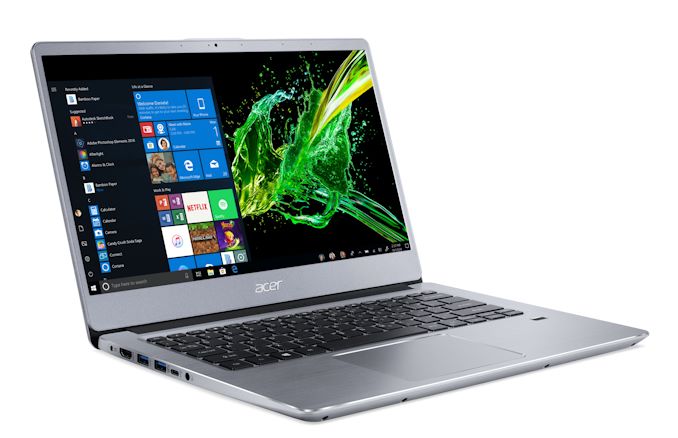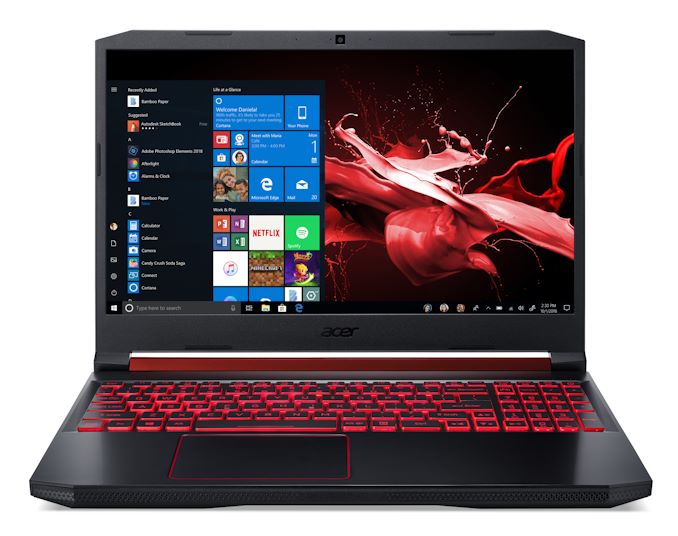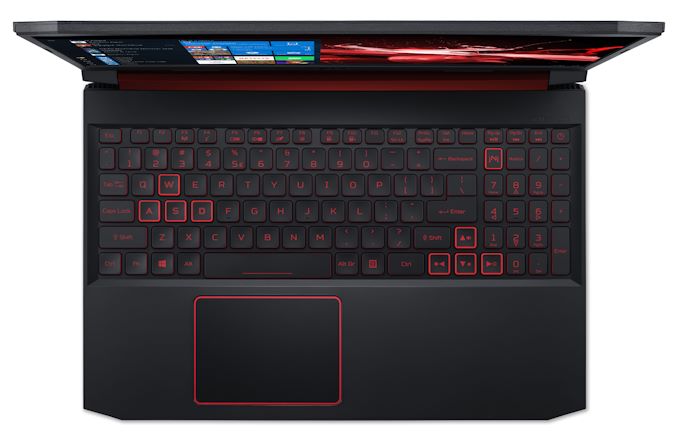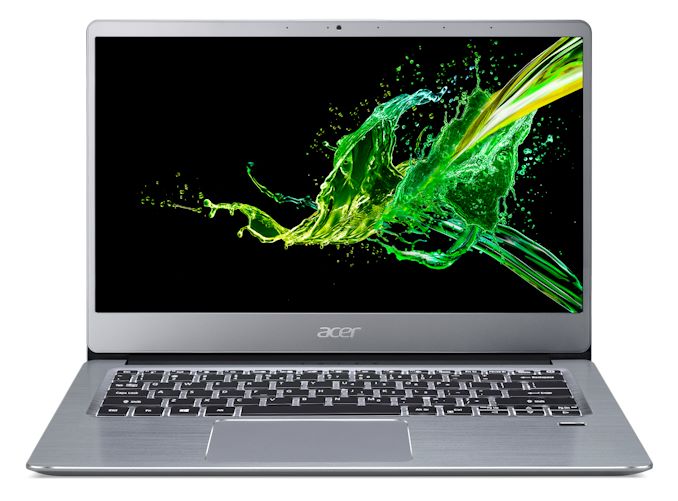Acer Updates Nitro 5 And Swift 3 Laptops With 2nd Gen AMD Ryzen Mobile
by Brett Howse on May 23, 2019 12:40 AM EST
Today Acer is announcing some updates to some of their AMD lineup, with the Acer Nitro 5 gaming laptop and Acer Swift 3 both being refreshed with the latest AMD Ryzen Mobile processors. We’ve taken a look at both the Nitro 5 and Swift 3 previous with the Ryzen 2500U and 2700U processors respectively. The Nitro 5 is a gaming system, and as such comes with a Polaris based GPU as well, but both laptops showcased that AMD has made tremendous strides in performance compared to their previous offerings.
Acer Nitro 5
The updated Nitro 5 will offer up to a 2nd Gen AMD Ryzen 7 3750H, which offers four cores, eight threads, and a 2.3 GHz base clock with a 4 GHz boost. The default TDP is 35 Watts, with a cTDP of between 12 and 35 Watts. The previous Nitro 5 ran its Ryzen 5 2500U in cTDP up mode, which allowed for up to 25 Watts of sustained power draw, so the Ryzen 7 3750H should allow for even higher sustained frequencies thanks to the extra headroom. As a gaming laptop, Acer also sells the Nitro series with a 45-Watt Intel offering, so there’s certainly enough cooling to handle the extra TDP from the new AMD CPU.
The GPU is still the AMD Radeon RX560X, which we found was similar in performance to a GTX 1050 laptop, although in gaming workloads that were more heavily CPU bound, the performance did drop back some. Hopefully with the new Ryzen 7 3750H that will no longer be the case.
Otherwise, the laptop is more or less identical to the previous model. It still offers a 15.6-inch 1920x1080 IPS display, and an appealing design. Acer’s Nitro 5 lineup offers a lot of value for a gaming system, and with these updates internals, that value should be even better. Acer hasn’t announced pricing yet, but it should be in-line with previous model which started at $669.99.
Acer Swift 3
Acer’s 14-inch Swift 3 also gets an upgrade. The CPU gets a bump from the Ryzen 7 2700U to the Ryzen 7 3700U as the top AMD choice. It features the same specifications as the 3750H, with a four-core, eight-thread design, with a 2.3 GHz base clock and 4.0 GHz boost clock. The major difference is the 3700U has a default TDP of 15 Watts, compared to 35 Watts in the H model. It also offers a cTDP of between 12 and 35 Watts, but as an Ultrabook class of notebook, Acer will almost certainly be offering this at the default TDP.
On the GPU side, the new 3700U comes with a Vega 10 by default, with a 1.4 GHz maximum frequency, but Acer is now offering an optional discrete Radeon RX 540X, which is the same Polaris based GPU as the Nitro 5 offers, but cut down from 16 compute units to 8. This may not be a huge performance update compared to the already impressive integrated Vega graphics of the Ryzen 7 3700U, but it should offer at least a small bump if only for not having to share the TDP with the CPU.
The 14-inch panel is IPS at 1920x1080, and will open to 180° if needed. The Swift 3 features an aluminum design that offers a great finish for a not too expensive laptop. As with the Nitro, Acer hasn’t announced pricing at this time, but expect it to be similar to the original Swift 3 which started around $699.99.
Source: Acer














30 Comments
View All Comments
fmcjw - Thursday, May 23, 2019 - link
on the subject of thermal design, a couple of sub-1kg designs such as some models in the LG Gram, Acer Swift 5, or Asus UX ranges are no doubt designed with the promised 10nm Intel SoC with 11-Gen graphics in mind, and certainly no discrete graphics, but instead had to stick more 14nm cores using the same lame HD 620 graphics that Intel is able to deliver. Thus, i7 SKUs often run worse than i5 (and I suspect i3-8130U/i3-8145U in some workloads) due to thermals. I'm not sure if the 7nm Ryzen is pin compatible with 12nm Ryzen. If they are, it's about time PC companies start pushing out 12nm Ryzen NOW in the form of those sub-1kg notebooks rather than waiting until the 7nm Ryzen lands, and rather than putting Ryzen in discrete GPU chassis designs unless it's for gaming.Irata - Thursday, May 23, 2019 - link
Have a Ryzen 2500U notebook and performance wise my kid can play Fortnite and similar games just fine at 1920x1080 with medium details. So I do agree that a weak dGPU is not really necessary.But as it's optional, I have no issues in case someone feels they need it.
Alexvrb - Thursday, May 23, 2019 - link
Yeah the unified chassis designs make it harder for these APUs to shine, but it isn't likely to change any time soon. The more egregious issue I see is systems that have 4GB of RAM soldered to the mainboard. With the AMD APUs, if you upgrade from 8GB (4 onboard, 4 in a stick) to 12 or 20GB, you lose dual channel and murder your GPU performance. But 8GB really isn't enough IMO, especially if you're sharing a couple gigs with the GPU.They need to make both channels user-serviceable SODIMMs on every AMD laptop.
abufrejoval - Thursday, May 23, 2019 - link
I struggled myself with that for some time, but it's making more and more sense to me these days:Problem sits in front of these machines: Users want machines that both run for a long time on batteries and offer gaming performance. At least they tend to accept that you need to plug it in when you game.
And as for single-channel vs. dual, it doesn't really get you into dGPU territory anyway, while the second DIMM may put you beyond the price point where it's worth selling the device. If you have a slot for a 2nd DIMM, then go and get crazy when RAM prices have stopped doing so (now seems a jolly better time than six months ago). It does get rather cramped in these ultrabooks, but at 2.3KG the Swift 3 is just as heavy as one of my GTX1070 based Skylake i7 so there should be plenty of space for an extra DIMM or three.
The iGPU part of the APU then gives you all the 2D and light 3D and VPU stuff that you need to last as long as possible on a charge, while the dGPU takes over for gaming.
On the Intel side of things, that's how they have done it with Nvidia for years now (subject to change, if Intel can carry it off) and here AMD and Acer are betting on the AMD software and driver team to deliver the type of integration in graphics and power management that can beat or at least draw close to what Intel and Nvidia have been able to do, certainly with enough of a price advantage to make it attractive for consumers.
I'd love to see if they can make that happen, because evidently they couldn't in the past, otherwise we'd have seen it before.
I am still somewhat "traumatized" by evaluating a 95Watt A10-7850K Kaveri with DDR3-2400 next to an i5-6267U with Iris Plus graphics (64MB of eDRAM as L4 cache): Both systems had pretty much 100% the same performance on any compute and graphics task that I could throw at both, yet the AMD was really overstepping the 100Watt mark every now and then, while the notebook with the i5 never sucked more than 30Watts from the power mains.
For many years Intel seemed very hard to beat on playing the idle and low power game while Nvidia was just as hard to beat at GPU performance per Watt at high power: AMD was using far too much power for far too little and now need to prove that they have at least become competitive.
Alexvrb - Thursday, May 23, 2019 - link
They're more than competitive on CPU power consumption, and have been ever since Zen hit, although Zen-enhanced (APU) and Zen+ (CPU) designs have refined it a bit.On the GPU side Navi should do pretty decent because of the smaller process and the mid-range initial targets, but it's hard to say what kind of gains we'll ultimately see.
yankeeDDL - Thursday, May 23, 2019 - link
Better late than never. Benchmark against Core gen 7?Krysto - Thursday, May 23, 2019 - link
Does anyone actually like red-font keyboards? Especially if the keyboards are not backlit, they are so difficult to read in even medium room light.lightningz71 - Thursday, May 23, 2019 - link
Don't miss the forest for the trees here, the big improvement for the Ryzen 3XXX APUs is significantly improved power management and boost characteristics. Previously, the 2xxx APUs had issues with idle power consumption, and an inability to balance performance with both thermal load and power draw. Enthusiasts made software tools that helped tailor those behaviors in their laptops and made significant improvements in platform performance, but they could never fix the power draw issues.This generation offers up a few hundred Mhz of base and boost performance improvement at each market point. It has the same iGPUs design, but with another few hundred Mhz of speed. Built in power management behaves much better, and, when pushing the platform while gaming or doing content creation, it behaves better with respect to achieving the best CPU Core performance AND iGPU graphics acceleration performance. Whereas before, it would either max out the iGPU or the CPU cores, but draw so much power or create so much heat, that it would have to run the other section at vastly lowered clocks to keep within its power budget.
The H series processors are also designed for higher power draw in total than the previous gen U series processors, allowing them to maintain their boost numbers for longer.
All in all, this looks like the mobile SKUs that AMD probably wishes they could have released the first time around. They will be more than competitive in their price points, so long as the OEMs have properly configured the laptops.
trivik12 - Thursday, May 23, 2019 - link
Aren’t Laptop chips SOC these days. So it needs integration. Does AMD makes things like Wifi modules to integrate them into SOC?I am curious about reviews for AMD 3xxx laptop chips. Do we have one. How does it do on idle power consumption? I might consider one if it’s good on that front.
lakedude - Saturday, May 25, 2019 - link
I paid $650 for the Intel i5/1050ti version of this laptop and I'm pretty happy with it. The Nitro 5 is a compromise but it is a good compromise. Previous gaming laptops were heavy and expensive while the Nitro is more portable and much cheaper. The specs are fantastic for a laptop in this price range.Memory was not soldered in and was easy to upgrade through a little hatch in the back of the laptop. Not sure why people are complaining about this unless the AMD version is very different. Remove one screw and you are in the memory area.
Remove another screw and you are in the hard drive expansion bay. My laptop came with a small M2 SSD but more storage can easily be added. The bay includes a mount, screws and a cable for a SATA drive.
My biggest complaint is the lack of an optical drive. I have purchased a USB external for those times when a drive is required but a built in would be more handy.
There are plenty of laptops in this price range that lack a decent video card and lack an SSD. I feel like I pretty much have it all.